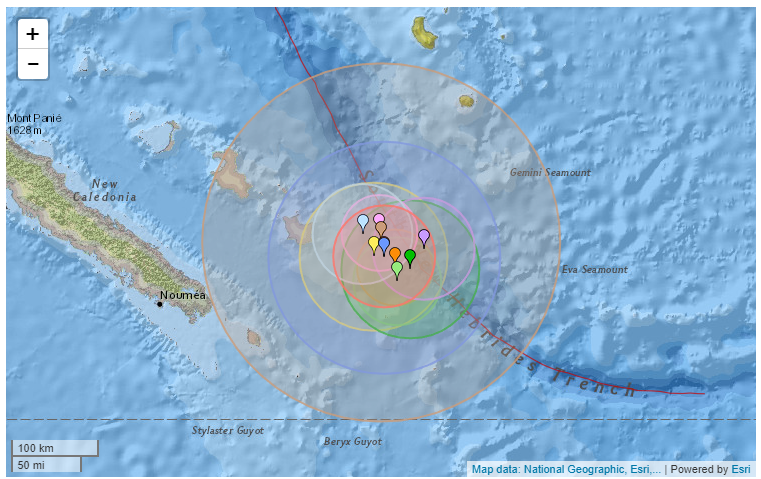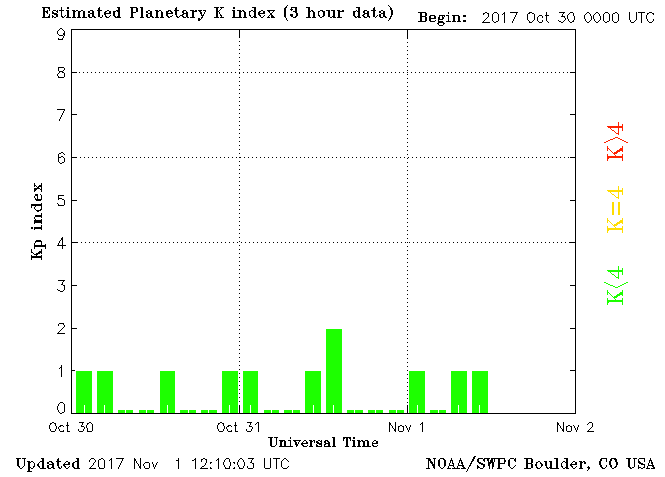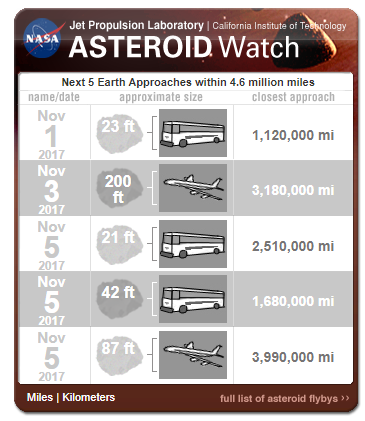Space Weather Daily News for 1 November, 2017
Solar Wind Watch, Quake/Tsunami, Vortices
To get started, the Sun's Earth facing disc was calm as the southern coronal hole moved off and the northern hole is starting to come into view. No eruptions that would head towards Earth, but plasma filaments didn't get active as soon as they were free of the Earth Facing Quiet.
Solar wind is low. The Planetary K-index is almost flat lined, but there are signs that a shift is going to happen soon as the southern coronal hole stream will reach Earth soon. When that happens, we will get some geomagnetic storms. Preceding the stream earthquakes watch was increased and we had a couple of big ones, one cause a tiny tsunami and apparently a bunch of aftershocks in New Caledonia.

There have been 20 earthquakes of 4.0 magnitude or greater in the last 24 hours in New Caledonia. Lucky, nobody would have noticed much of anything.

Source: https://earthquaketrack.com
- 6.1 magnitude earthquake in New Caledonia
- 6.6 magnitude earthquake in New Caledonia
- [6.0 magnitude earthquake[(https://earthquaketrack.com/quakes/2017-11-01-05-09-00-utc-6-0-10) in New Caledonia
I have a theory that the magnetic pole shift will be preceded by a lot of activity near Vanuatu. Other people have speculated that at the current movement of the north and south magnetic poles, they should reach each other just off the bottom of Africa in the Atlantic. I theorize that that with that happens, there must be a relative reaction on the other side of the planet. Just a theory with nothing to back it up, other than a hunch. So, I think, that with more activity with Vanuatu, there could be more movement of the poles. I don't know if that is related to the North Pole earthquakes we just had 4 days ago.
- Weatherwatch: vortex 'streets' that can flatten power stations . Well, another way the power goes out and causes havoc.
- ICON Scans the Ionosphere. Cool video of the data from ICON. Man-made global warming is going to take a hit when they keep getting more data from ICON.
- The NEOs database filled up for Nov. 5th, but nothing within the 1 million mile distance.
~ Ben Davidson (Suspicious0bservers ) at SuspiciousObservers.org
I am not affiliated with Ben Davidson or his work. I am a subscriber to SuspiciousObservers YouTube channel.
- Space Weather News
- Quake Watch
- Earth Changes - mobile app
- STARWATER
Space Weather


Source: http://www.swpc.noaa.gov/products/planetary-k-index
Asteroid Watch

Average distance between Earth and the moon is about 239,000 miles (385,000 kilometers).
Source: https://www.jpl.nasa.gov/asteroidwatch/
| Name | Flyby Date | AU distance | Approximate Sixe |
|---|---|---|---|
| 2017 UD43 | 2017-Nov-01 | 0.01203 | 5.5 m - 12 m |
| 2017 UL44 | 2017-Nov-03 | 0.03417 | 48 m - 110 m |
| 2017 UX42 | 2017-Nov-05 | 0.02696 | 4.9 m - 11 m |
| 2017 US7 | 2017-Nov-05 | 0.01812 | 10.0 m - 22 m |
| 2017 UJ7 | 2017-Nov-05 | 0.04295 | 21 m - 46 m |
| 2017 UJ43 | 2017-Nov-05 | 0.01167 | 7.0 m - 16 m |
Close Approach Database
Source: https://cneos.jpl.nasa.gov/ca/



thank you for informations.